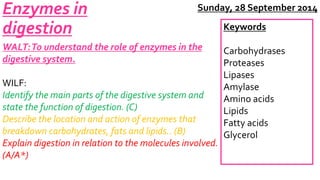B2-3.3 enzymes in digestion
•Télécharger en tant que PPTX, PDF•
3 j'aime•2,630 vues
Signaler
Partager
Signaler
Partager

Recommandé
Contenu connexe
Tendances
Tendances (20)
Essential Biology 6.6 & 11.1 Reproduction Core & AHL

Essential Biology 6.6 & 11.1 Reproduction Core & AHL
En vedette
En vedette (20)
Chapter 5 Enzymes Lesson 1 - Introduction to Enzymes

Chapter 5 Enzymes Lesson 1 - Introduction to Enzymes
overview of the digestive system and diseases of it

overview of the digestive system and diseases of it
AQA AS Biology - Unit 1 - Biology and Disease - Chapter 2 (2.1 and 2.4) - Dig...

AQA AS Biology - Unit 1 - Biology and Disease - Chapter 2 (2.1 and 2.4) - Dig...
Similaire à B2-3.3 enzymes in digestion
Similaire à B2-3.3 enzymes in digestion (20)
CHAPTER 22 Nutrition and MetabolismSTUDENT LEARNING OBJECTIVES

CHAPTER 22 Nutrition and MetabolismSTUDENT LEARNING OBJECTIVES
Plus de Miss Lavin
Plus de Miss Lavin (20)
AS-U1-2.3 Carbohydrates-disaccharides and polysaccharides

AS-U1-2.3 Carbohydrates-disaccharides and polysaccharides
B2-3.3 enzymes in digestion
- 1. Enzymes in digestion WALT: To understand the role of enzymes in the digestive system. Sunday, 28 September 2014 WILF: Identify the main parts of the digestive system and state the function of digestion. (C) Describe the location and action of enzymes that breakdown carbohydrates, fats and lipids.. (B) Explain digestion in relation to the molecules involved. (A/A*) Keywords Carbohydrases Proteases Lipases Amylase Amino acids Lipids Fatty acids Glycerol
- 2. What do we know about enzymes so far?! Starter Complete the questions on your work sheet to summarise what you’ve learnt about enzymes so far.
- 3. List as many organs as you can think of that are involved in the digestive system. From this… To this…
- 4. The Digestive Mouth System Liver Oesophagus (Gullet) Stomach Pancreas Large intestine Gall bladder Small intestine Anus
- 5. The digestive system The alimentary canal (a muscular tube) along with a range of organs and glands make up the digestive system. Function? To break down large insoluble molecules of food into smaller soluble ones, digestion. e.g. carbohydrate glucose Peristalsis
- 6. Enzymes and the digestive system Digestive enzymes: ~ work outside of your cells ~ produced by glands ~ pass into the gut and break down, catalyses, LARGE INSOLUBLE MOLECULES into smaller soluble molecules
- 7. Carbohydrates Broken down into sugars Enzyme carbohydrase Proteins Broken down into amino acids Enzyme protease Lipids (fats and oils) Broken down into fatty acids and glycerol Enzyme lipase
- 8. B1 Link! Diet and exercise (1.1) Keywords Malnourished Metabolic rate Inherited C: List the components of a balanced diet and define the term malnourished . B: Describe how the amount of energy you need to live depends on different factors. A/A*: Explain what the term metabolic rate means and factors which can affect it. Pgs. 24-25
- 9. Task 1: Complete Qu 1. from the summary box on pg 169. Task 2: Explain how digestive enzymes are different to other enzymes in the body. Task 3: Glue in and complete the table showing the function of the different digestive enzymes in the body. Large molecule Smallmolecule Enzyme Where is it produced? Carbohydrates Proteins Lipids
- 10. Investigating digestion Test for starch? Use iodine, a positive result is shown as blue-black colour. Test for sugar (glucose)? Use Benedict’s, a positive result is shown as red colour.
- 11. Odd One Out! Spot the odd one out in these lists and give a reason for your answer. There may be more than one answer! 1. Carbohydrases, proteases, glucose 2. Lipids, proteins, amino acids
- 13. Large molecule Smallmolecule Enzyme Where is it produced? Carbohydrates Proteins Lipids Large molecule Smallmolecule Enzyme Where is it produced? Carbohydrates Proteins Lipids
Notes de l'éditeur
- Flash Up! Provide pupils with blank diagram and allow 1 minute to simply just look at the diagram and take in as much as they can. The allow 2 minutes to label their diagram as much as they can. Briefly introduce functions of main organs (mouth, stomach, pancreas and small intestine)
- ase-=enzyme
